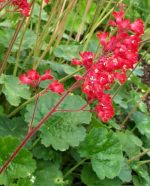
Native to the cliffs,hills and alpine areas of Arizona and New Mexico, this evergreen herbaceous perennial is a member of the saxifrage family, Saxifagaceae, that also include tiarella, bergenia, and astilbe. Plants forms a 8-10″ wide clump of leaves carried on softly hairy petioles up to 5″ long. The leaves are 1-2″ wide, rounded to kidney-shaped, and have 5-7 toothed lobes. In late spring bell-shaped red flowers 1/2″ long appear in loosely branched panicles 10-20′ long and persist for 4-8 weeks. H. sanguinea is a parent of most of the hybrids in gardens today and are usually listed under H x brizoides. With their long bloom time, plants are a good choice for rock gardens, borders, and woodland gardens but also are good as a ground cover. The genus name, Heuchera, honors Heinrich von Heucher (1677-1747) a botanist, physician, and medicinal plant expert at Wittenberg University, Germany. The specific epithet, sanguinea, comes from the Latin word sanguis meaning blood and refers to the color of the flowers.
Type: Evergreen herbaceous perennial
Bloom: Bellshaped, red 1/2″ long flowers in loose panicles 10-20″beginning in late spring and lasting for 6-8 weeks
Size: 12-18″ H x 12″ W
Light: Full sun to part shade; even moisture needed in full sun, shade needed in warm climates.
Soil: Organically rich, medium moist, well-drained; does not tolerate heavy or acid soil; drought tolerant when established.
Hardiness: Zones 3-8
Care: Deadhead to prolong bloom time; mulch to prevent heaving; divide when crowns become woody or every 3-4 years.
Pests and Diseases: None of significance
Propagation: Division in fall, seed of species
Companion Plants:Yarrow, Mexican feather grass, hosta, golden hakane grass
Outstanding Selections: See Plant Profile of Heuchera brizoides for possibilities